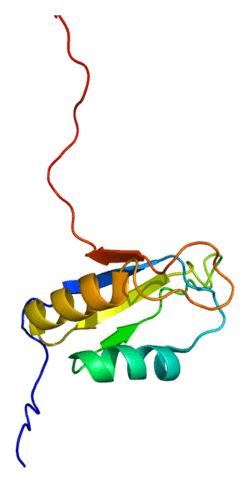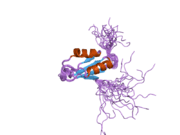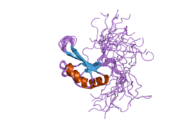CUGBP Elav-like family member 4
CUGBP Elav-like family member 4 (CELF4) also known as bruno-like protein 4 (BRUNOL4) is a protein that in humans is encoded by the CELF4 gene.[4][5]
Function
Members of the CELF/BRUNOL protein family contain two N-terminal RNA recognition motif (RRM) domains, one C-terminal RRM domain, and a divergent segment of 160-230 aa between the second and third RRM domains. Members of this protein family regulate pre-mRNA alternative splicing and may also be involved in mRNA editing, and translation. Several transcript variants encoding different isoforms have been found for this gene, but their full-length nature has not been determined yet.[5]
gollark: The ability for lasers to lase other lasers, I mean.
gollark: Anti-laser lasers would be quite a fun feature to add to plethora.
gollark: Most of my laser-using programs just go for the simple but naive solution of firing toward the current position of whatever's being targeted.
gollark: Huh. That is much more advanced than my brief attempt at improved laser targeting, which just got the target's current position, figured out how long it would take for the laser to reach that, then added that times its velocity to the target position.
gollark: Sadly, for cost and claims-weirdness reasons they are no longer deployed in Keansia.
References
- GRCm38: Ensembl release 89: ENSMUSG00000024268 - Ensembl, May 2017
- "Human PubMed Reference:". National Center for Biotechnology Information, U.S. National Library of Medicine.
- "Mouse PubMed Reference:". National Center for Biotechnology Information, U.S. National Library of Medicine.
- Good PJ, Chen Q, Warner SJ, Herring DC (Oct 2000). "A family of human RNA-binding proteins related to the Drosophila Bruno translational regulator". J Biol Chem. 275 (37): 28583–92. doi:10.1074/jbc.M003083200. PMID 10893231.
- "Entrez Gene: BRUNOL4 bruno-like 4, RNA binding protein (Drosophila)".
External links
- Human CELF4 genome location and CELF4 gene details page in the UCSC Genome Browser.
Further reading
- Szafranski K, Schindler S, Taudien S, et al. (2008). "Violating the splicing rules: TG dinucleotides function as alternative 3' splice sites in U2-dependent introns". Genome Biol. 8 (8): R154. doi:10.1186/gb-2007-8-8-r154. PMC 2374985. PMID 17672918.
- Han J, Cooper TA (2005). "Identification of CELF splicing activation and repression domains in vivo". Nucleic Acids Res. 33 (9): 2769–80. doi:10.1093/nar/gki561. PMC 1126903. PMID 15894795.
- Singh G, Charlet-B N, Han J, Cooper TA (2004). "ETR-3 and CELF4 protein domains required for RNA binding and splicing activity in vivo". Nucleic Acids Res. 32 (3): 1232–41. doi:10.1093/nar/gkh275. PMC 373409. PMID 14973222.
- Tchernev VT, Mansfield TA, Giot L, et al. (2002). "The Chediak-Higashi protein interacts with SNARE complex and signal transduction proteins". Mol. Med. 8 (1): 56–64. doi:10.1007/bf03402003. PMC 2039936. PMID 11984006.
- Ladd AN, Charlet N, Cooper TA (2001). "The CELF family of RNA binding proteins is implicated in cell-specific and developmentally regulated alternative splicing". Mol. Cell. Biol. 21 (4): 1285–96. doi:10.1128/MCB.21.4.1285-1296.2001. PMC 99581. PMID 11158314.
- Bonaldo MF, Lennon G, Soares MB (1997). "Normalization and subtraction: two approaches to facilitate gene discovery". Genome Res. 6 (9): 791–806. doi:10.1101/gr.6.9.791. PMID 8889548.
This article is issued from Wikipedia. The text is licensed under Creative Commons - Attribution - Sharealike. Additional terms may apply for the media files.




